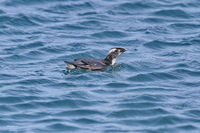| Japanese Murrelet | |
|---|---|

| |
| Scientific classification | |
| Kingdom Information | |
| Domain | Eukaryota |
| Kingdom | Animalia |
| Subkingdom | Bilateria |
| Branch | Deuterostomia |
| Phylum Information | |
| Phylum | Chordata |
| Sub-phylum | Vertebrata |
| Infraphylum | Gnathostomata |
| Class Information | |
| Superclass | Tetrapoda |
| Class | Aves |
| Sub-class | Neornithes |
| Infra-class | Neoaves |
| Order Information | |
| Superorder | Passerimorphae |
| Order | Charadriiformes |
| Infraorder | Charadriides |
| Family Information | |
| Superfamily | Laroidea |
| Family | Alcidae |
| Sub-family | Alcinae |
| Tribe Information | |
| Tribe | Synthliboramphini |
| Genus Information | |
| Genus | Synthliboramphus |
| Species Information | |
| Species | S. wumizusume |
| Population statistics | |
| Population | ca. 10,000 (2015 est.) |
| Conservation status | Vulnerable[1] |
The Japanese murrelet (Synthliboramphus wumizusume) is a small species of seabird of the family Alcidae, and found primarily in the waters adjacent to Japan and southern Korea.
Contents
Description[edit]
It is a small bird, about 8 inches long and weighs about 5.8 ounces. The back of the body is black and bluish gray, the flanks are grayish, and the chest and belly are white, extending no higher on the neck's underside than the chin. The top of the head bears a large, white "V" of feathers, extending from both eyes to meet at a point at the back of the head. Within this vertex is a short, black crest, giving the bird its other name of "crested murrelet". It bears a bluish-gray bill. Females are similar in size and color.
The adult winter plumage lacks the white head feathers as well as the crest. Instead, the head is consistently blackish-gray, with the chin having an individually varying gray color. Young birds resemble the adult birds in winter, but have a shorter and slimmer beak.
Range[edit]
The Japanese murrelet breeds exclusively in the coastal waters of Japan, on some islands off the South Korean coast and possibly on a bay near Vladivostok, Russia in the Sea of Japan. The species prefers to stay in marine regions with a warm current. This applies in particular to the waters around the islands off Kyushu and the Izu Islands.
Breeding colonies are located on at least twelve islands off the coast of Honshū and Kyushu. The most important breeding area is the Izu Islands, where at least three islands in this chain are breeding colonies. It is also assumed that breeding colonies are also on islands off the South Korean coast. Outside the breeding time Japanese murrelets migrate to the north and then reach Sakhalin, the Kurils and waters of northeastern Hokkaido.
The Japanese murrelet seeks food during the breeding season in nearby coastal waters. Outside the breeding season, it stays on the open sea year-round on waters that have a surface temperature between 8 and 22 degrees Celsius. On the high seas, the Japanese murrelet is usually observed in small groups. Little is known about its food ecology, but it probably is similar to other related murrelets in that it feeds on small, largely juvenile fish, small sand eels, and krill.
Breeding[edit]
Japanese murrelets breed primarily on small, rocky islands or islets, with the nests usually located a few hundred yards from the coast. The nest is located in crevices, within cracks of rocky cliffs, and in cavities under rocks. They also dig burrows under tufts of grass. Breeding birds live close to their breeding colonies from February to May, with the actual egg laying taking place at the end of February, ending in March. The small family groups then leave the breeding colonies from April to early May.
The clutch almost always consists of two eggs. These are creamy yellow to reddish brown with brown spots and scribbles, with some eggs heavily marked. Both parents are involved in brooding, which can last up to 31 days, and like other murrelets eggs that have not been brooded for several days will still hatch. The young birds usually spend one to two days in the nest and then leave the breeding colony together with the parents. The rearing of young birds, which takes place on the high seas, has not been sufficiently investigated.
Threats[edit]
The islands in which the birds breed are primarily offshore islets and reefs, and are largely uninhabited by man. Still, these islands have attracted fisherman either for sport or commercial reasons, and their presence has affected the murrelet population based on the following factors:
- the presence of the Norway rat (Rattus norvegicus) on several islands as a result of landings by fisherman; these animals caused a severe decline in murrelet numbers, and leading to a near-extinction on the island of Koya-jima.
- The tossing of unwanted by-catch in surrounding waters, which has attracted gulls and crows; these birds in turn predated murrelet eggs and chicks.
- Decline of fish stocks due to temperature change in the waters off the Izu Islands.
- Unattended drift nets, causing an estimated 1-10% of the murrelet population.